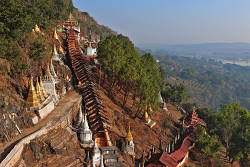ပင်းတယရွှေဥမင်
Pindaya Cave
Useful Information
| Location: | In the hill above Pindaya village. |
| Open: |
All year daily 6-18, [2020] |
| Fee: |
Adults MMK 3,000. Foto and Video Permit MMK 300. [2020] |
| Classification: |
 Karst Cave Karst Cave
 Cave Church Cave Church
|
| Light: |
 Electric Light Electric Light
|
| Dimension: | |
| Guided tours: | self guided |
| Photography: | allowed with permit |
| Accessibility: | no |
| Bibliography: | |
| Address: | |
| As far as we know this information was accurate when it was published (see years in brackets), but may have changed since then. Please check rates and details directly with the companies in question if you need more recent info. |
|
History
| 1750 | beginning of use as a temple. |
| 1773 | date on oldest known buddha statue. |
Description

ပင်းတယရွှေဥမင် (Pidaya Caves) are natural karst caves of some size, passages up to 10 m high, with many speleothems. But they are famous for their artificial content, virtually thousands of Buddha statues in all shapes and sizes. The cave is used as a holy place and buddhist temple, so it is actually heavily damaged by the use and most speleothems are destroyed. The side passages are numerous and used for meditation and praying.
The Buddha statues cover most of the main chamber and almost every corner of the cave. The origin of the statues is not known, it seems clear that they were created over a very long time, by different artists using completely different materials and techniques. Some are made of teak wood, the main export article of Myanmar, others are made of alabaster, brick, marble, plaster, or even cement. Some are covered by lacquer but most are covered by gold. Today statues are newly installed by Buddhist organizations from as far as Singapore, Netherlands, and the USA.
The current amount of statues is somewhere between 8,000 and 9,000, and there are different exact numbers given, it seems to be rather difficult to count them. The number we read most often is 8,094, so we guess there is a chance that this might be the true number.
The huge monastery around the cave is named Shwe Oo Min Pagoda. There are virtually thousands of golden stupas, starting at a huge field where they are aligned in rows, along the trail to the cave, and after the cave the trail goes further up the hill with even more. The main buildings of the monastery are above the cave at the flank of the hill. The trail forms a loop along the cave and monastery and is covered by thousands of small roofs, which provide protection from the hot sun or from heavy rains during monsoon.
 Search DuckDuckGo for "Pindaya Cave"
Search DuckDuckGo for "Pindaya Cave" Google Earth Placemark
Google Earth Placemark Pindaya Caves - Wikipedia (visited: 04-AUG-2020)
Pindaya Caves - Wikipedia (visited: 04-AUG-2020) Pindaya Cave, Myanmar | AsiaExplorers Travel Guides
Pindaya Cave, Myanmar | AsiaExplorers Travel Guides Index
Index Topics
Topics Hierarchical
Hierarchical Countries
Countries Maps
Maps